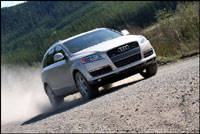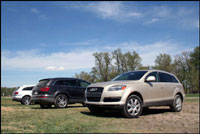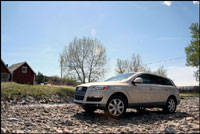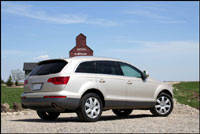Hitting Jackpot on the First StrikeWhether you like it or not, sport utility vehicles are taking over the
 |
| Every luxury car company needs an SUV. Audi's is the Q7. (Photo: Justin Couture, Canadian Auto Press) |
world, and what's more is that they're here to stay. SUVs to the left, to the right, in North America, Europe and Asia, in jungles, on deserts and in your local grocer's parking lot. Sport utilities up to our eyeballs. They're all over the place, but it's not as if this is a problem; we like them, and the reason they're filling up the landscape is that they're replacing a lot of traditional automobiles. Instead of a limousine, the wealthy go for a Range Rover. Need something that'll gun down a sports car, but still able to tow a boat? Try a Cayenne Turbo on for size. And even for some of the more mundane kinds of automobiles, such as people-moving minivans, station wagons, or compact cars, there's an SUV or a crossover that fits the bill. The world's population just can't get enough of these machines, and automakers just can't seem to crank them out fast enough. All this talk has even managed to sway Audi, a brand that has never built an SUV before, into creating one.
Late
 |
| A herd of Q7s, basks in the bright, Albertan sun. (Photo: Justin Couture, Canadian Auto Press) |
is a word that would most accurately describes the arrival of the Q7, and not just casually late or the type that's considered fashionable, but the kind of late where all the food at the party's mostly eaten and what isn't is now cold. Nevertheless, there's good justification for Audi's tardiness; during the early days of the SUV boom, the German luxury division kept a keen eye on the marketplace and has observed an entire generation of SUVs from the very beginning. Instead of jumping into the fray from the beginning, it invested the time to observe. It was time well spent, unlike some others it's had the opportunity to see that body-on-frame chassis configurations only work for traditional off-road-specified 4x4s. For most owners that heavy-duty running gear designed to take you deep into God's country isn't necessary, and at the end of the day people want the flexibility of a tall wagon-like structure combined with sport-sedan-like performance. Such is the power of the thinking brand.
So, with mounds of information at its disposal Audi set out to create
 |
| It might not have the off-road gear of a Touareg, but the Q7 is certainly capable off the road. (Photo: Justin Couture, Canadian Auto Press) |
what would be the perfect modern performance sport utility vehicle - the kind of machine that's sure to make inroads within one of the market's most desirable categories. But, instead of doing things from scratch, it's saved time and money by using the architecture that's currently employed by Porsche and Volkswagen for their SUVs. Audi is quick to say that this isn't just another clone; the Q7 is significantly different than the others due in part to Audi's less excruciating demands. Less? Keep in mind, that unlike the Touareg or Cayenne, which have to perform equally well both on and off the road, the Q7 isn't designed to take you up sheer rock faces on the trails around Moab, Utah, where VW introduced its off-roader. Not only is its suspension lighter, but it's made of daintier aluminum, and thanks to its soft-roader duties, it's the only member of the VAG SUV family not to feature a transfer case.
By
 |
| It might not seem as if any weight saving is going on, but there is, in the body and in the running gear. (Photo: Justin Couture, Canadian Auto Press) |
volume, you'll find more aluminum in the Q7 than its stable mates - yes, even more than the sporty Porsche - the majority of which is in place to lighten the body. Although Audi is one of the masters of aluminum, capable of whipping up aluminum space frames for everything from a micro city car and stretch limo to ones for Bugatti and Lamborghini, it just wasn't financially viable to convert the existing unitary chassis into a space frame like the one you might find under the skin of an A8 or A2. What they've done instead is stamp the hood, the doors and tailgate out of aluminum, changes easy to adapt, but crucial for saving weight. These modifications make a difference, but, to the unobservant, the effort seems somewhat futile: kilo for kilo the Q7 is still as heavy as the off-road-ready Touareg (or a V8 Porsche Cayenne, for that matter). Why? Well, the Q7 is a giant; it dwarfs the aforementioned vehicles, not to mention BMW's X5 and Volvo's XC90.






